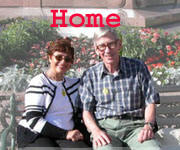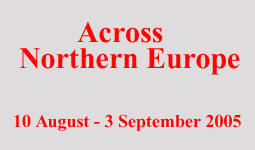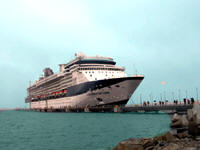Part II - Page 8 9 10 11 12 Go to: Part I Part III Part IV
RIGA
We had signed up for two excursions here. Our Riga City Tour left at 9:40, taking us into the Old Town (Vecriga) for a walking tour. The sunny weather was back. We started in Town Hall Square (Ratslaukums) where we saw the Town Hall, Roland’s Statue, and the House of the Blackheads. The latter was a 14th century guild house. Both buildings (along with the statue and the entire square) were destroyed in a German air raid in1941 and were only recently restored (1995-1999). The incongruous modern building of the Museum of the Occupation is also on the square.
We walked to nearby St. Peter’s Church, a red brick Gothic structure dating from 1209 but rebuilt several times. It was restored most recently in 1973 after burning down during World War II. Just behind it was St. John’s Lutheran Church (1582) with a step-pediment, the first Latvian church in Riga. Our guide led us on to Livu Square. On the east side are two old guild houses, the Great Guild (1857) and the Small Guild (1863), in very different styles. Right across the street is the House of Cats, so-called because of the cat sculpture perched on the peak of each of its two towers. The story goes that the owner of the house commissioned the cats after his membership in the Great Guild was rejected. Initially, they were positioned with their rear-ends facing the guild and with their tails straight up. Taking this as the insult it was intended to be, the guild successfully sued to have the cats repositioned to face the Guild.
We walked through the narrow streets until we came to the Powder Tower (1330 but rebuilt in the 17th century ), once a part of the city walls (now a museum).
Continuing our walk, we entered Dom Square, site of the Lutheran Cathedral (1215; rebuilt 16th century). We had a few minutes free time before we had to gather at 11:40 for the organ recital in the Cathedral. The organist played a nice selection of music, from very heavy to relatively light. The recital finished at noon and we all headed back the bus. We rode past Riga Castle, originally built by the German knights around 1330 but rebuilt and expanded so much (through 1818) that it has lost any medieval characteristics. It now serves as the Presidential Palace. We got back to the ship at 12:40 and went right to lunch.
Our next excursion, Latvian Open Air Ethnography Museum, left at 2:30. We drove by the Central Market whose buildings were originally hangers for zeppelins. Of course, we passed a typical Soviet-era building with the Stalinist style of architecture we’d seen in Poland and Russia. Our guide kept pointing out every wooden house we passed, as though they were a rarity. She was young, and I suppose they weren’t building with wood anymore.
We drove across some very flat countryside, arriving at the Ethnographic Museum (1924) at 3:20. It was located in a pine forest on the coast of Lake Jugla. Like similar museums we’d seen in other countries, this one had structures from all over the country. It occupied about 200 acres and had ninety buildings, mostly from the 16th to the 19th centuries. Most interesting was the old wooden church with its entire wood ceiling painted with figures.
At 4:30 we gathered at the old roadside tavern, an incredibly long building, where a Latvian folk group sang and danced traditional Latvian folk music for us.
As we drove back through Riga, we thought it looked very run down compared to the other cities we’d seen on the cruise (or compared to Klaipeda, which we were yet to see). But then we hadn’t driven as far from the city center as we did here. We got back to the ship at 6:00 and went right to dinner. The ship sailed at 7:00 as we ate. Our departure was more interesting this time because the Constellation had to back across the river to turn around. Then, as we sailed the several miles to the mouth of the river, there were crowds of people all along the way, gathered to watch the ship, apparently one of the largest ever to visit the city.
Part II - Page 8 9 10 11 12 Go to: Part I Part III Part IV |



























